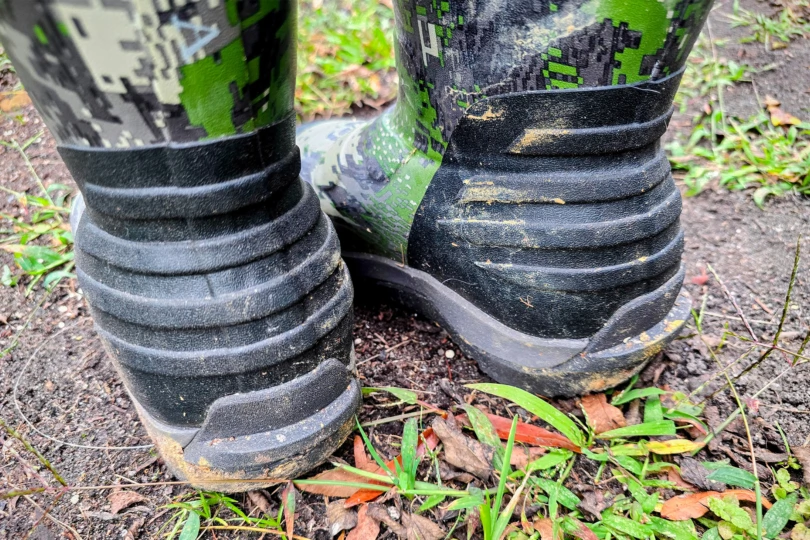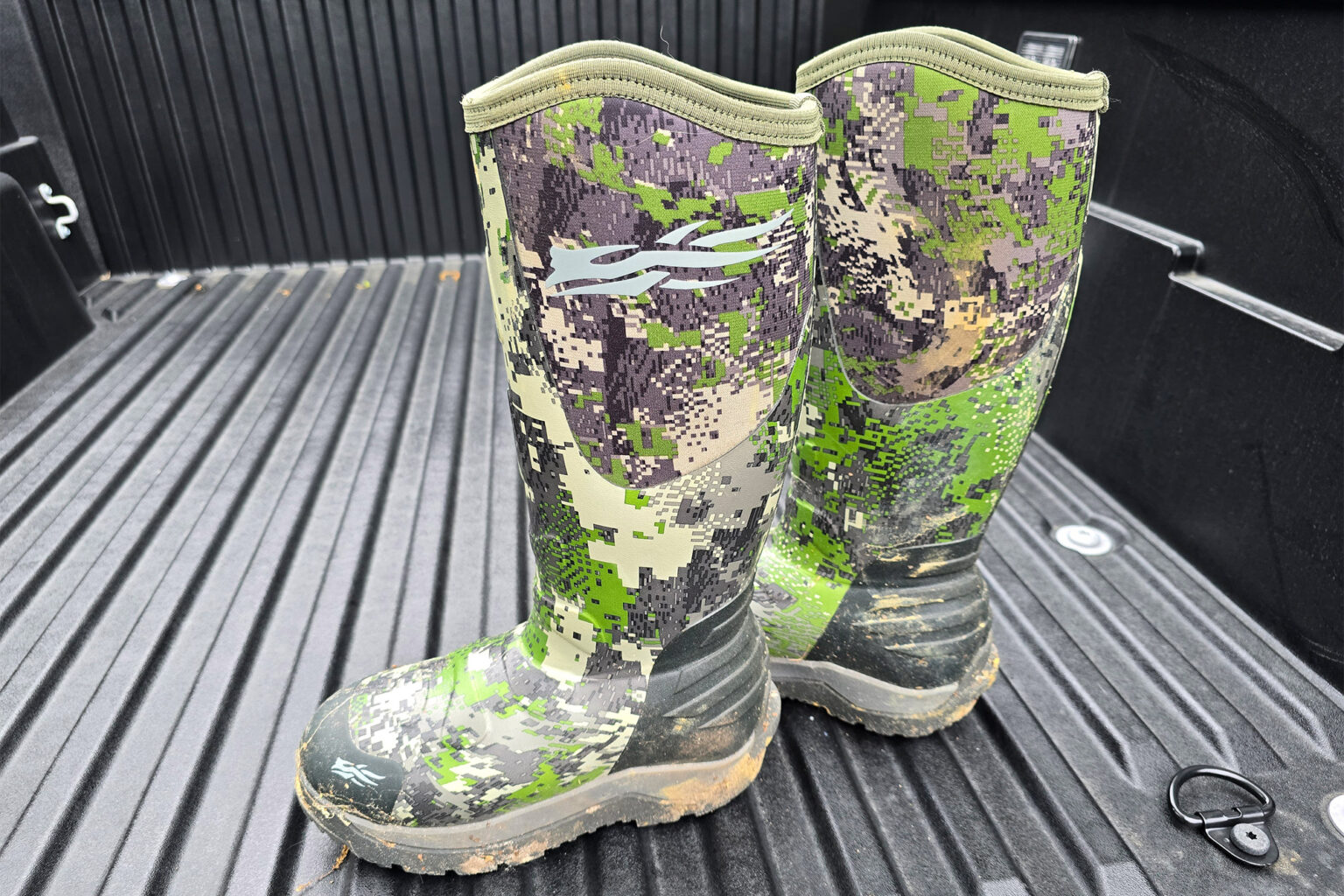SITKA has made a name for itself by pushing the limits of comfort and performance with gear that actually performs in the field. The brand’s jackets, pants, and base layers are high-tech and modern, but not fussy. It’s just the kind of gear hunters can rely on day in and day out in pretty much every condition Nature throws our way.
SITKA took the same approach when the company designed the Back40 Boot. Far from the typical rubber boot, these feel almost like sneakers underfoot. That is, if sneakers were tough enough to tackle swamps, creeks, and muddy timber.
In short: If you’ve ever wished for a boot that can keep your feet dry without making you dread the hike, the Back40 is SITKA’s attempt to hit that sweet spot.
SITKA Back40 Boot Review
-
Extremely comfortable for a rubber boot -
Great traction on mud and slopes -
Easy to get on and off -
Waterproof and breathable performance
-
Heavy for long hikes -
No half sizes; fit runs roomy
First Impressions
Out of the box, the SITKA Back40 looks like a heavy-duty rubber boot. They’re tall, thick, and look more like they’re built for mucking stalls than sneaking through timber. But once I pulled them on, the fit tells a different story.
SITKA designed these to feel more like athletic footwear underfoot, and somehow almost pulled it off. The EVA midsole and molded footbed give the boot a surprising amount of cushioning and rebound, which I noticed as soon as I started walking.
But these are still hefty beasts. Each size 7 boot tipped the scale at 2.6 pounds. They aren’t lightweight, and I definitely won’t be running any trail races in them. But that’s not what they’re for. Like the ag boots they resemble, these things are built for mud and muck. And I wouldn’t want to wade through either in cross trainers.
SITKA doesn’t make half sizes, so I went up from my usual 6½. That left a little extra room, even with thick wool socks. My feet slid around some, but the overall comfort was solid right from the start. They’re not sleek or flexible. They’re still tall rubber boots, after all. But the comfort level puts them a step above most others in the category.
Field Testing in the South’s Spring Turkey Season
I initially put SITKA’s Back40s through their paces in the heart of the South’s spring turkey season, which is a mix of thick black mud, swollen creek beds, and dew-soaked grass that can be brutal in cheap boots. The Back40’s 18-inch shafts kept water out through repeated soakings, keeping my feet impressively dry even in seriously sloppy terrain.
Even with 800 g of Thinsulate, the boots stayed comfortable on cool spring mornings that warmed into the 60s. The liner and footbed wicked moisture well, and though my socks ended up damp by the end of the day, the breathability puts every other waterproof rubber boot I’ve used to shame.
But I found the boot’s limit when I carried them into the early North Carolina archery season. Afternoon temps routinely climb into the 90s, and while airflow was decent, the insulation and weight made them too much boot for hot-weather hunting.
By the end of those mid-September sits, my socks felt like the swamps I’d slogged through back in turkey season. I’ve since shelved them until the first November cold snap, when that insulation will earn its keep.
The boots’ heel kick pad is a small but appreciated feature that makes it easy to peel off muddy boots at the truck. It’s the kind of feature you don’t think about until you’re tired and covered in swamp muck.
Fit and Comfort




SITKA built the Back40 around a sneaker-inspired last, and it’s easy to feel. Out of the box, it feels more like you’re standing in an athletic shoe than a boxy rubber boot. These boots are cushioned underfoot, snug through the midfoot, and surprisingly flexible in the step.
Since SITKA doesn’t offer half sizes, I sized up from my usual 6½. That left extra room even with thick wool socks, and while my feet slid a bit on steep terrain. But the extra space ended up not being a deal breaker.
I came away from multi-mile hunts with no blisters or hot spots. The EVA midsole and molded foam footbed absorbed shock well and helped prevent foot fatigue on all-day hunts.
Each boot weighed 2.6 pounds according to my kitchen scale, so these are far from lightweight. I noticed the heft on longer hikes, but for a rubber boot, these are pretty darned comfy. They are easily some of the most supportive, well-cushioned rubber boots I’ve worn.
Stability and Traction
The Back40s rubber outsoles really impressed me during testing. They bit into slick, muddy ground without that ice-skating feeling you get with cheaper boots. They also stayed planted in sandy soil and shed debris over mixed terrain without caking up with grit, mud, or leaves.
The tread pattern offers plenty of grip on uneven ground. I was able to sidehill through damp leaf litter and mud-slick creek banks with no trouble.
Traction feels more like a light mountain boot than a traditional rubber pull-on, with plenty of bite where rubber soles like to slide. The extra mass might require strong leg muscles on long hauls, but it lends some balance and stability when the footing gets unpredictable. These will never identify as lightweight hiking boots, but they stay solid underfoot and inspire confidence in sloppy conditions.
Durability




After more than a full season of trudging through muck, mud, sand, and the occasional creekbed, the Back40s still look basically brand new. There’s no cracking or fading, and the molded EVA midsole still provides solid support. The outsole treads have just as much bite as they did on day one, and I can’t detect even minimal wear despite repeated use in slippery conditions.
And after miles of wet grass, creek crossings, and trips through swampy river bottoms, the boots are still repelling water like moisture-fighting super heroes. Even the heel kick pad had held up.
Where They Excel
The Back40s are rockstars when it comes to waterproofing and traction. They keep feet dry in mud, swamps, creeks, and dew-soaked grass without baking them in mild temperatures thanks to their breathable construction. The rubber outsoles offer plenty of grip, biting into slick creek banks, sandy soil, and uneven terrain.
These boots are also surprisingly comfortable and easy to wear, even on long, active days in the field.
Where They Fall Short
But like most rock stars, these boots have their vices. At over 2½ pounds per boot, the Back40s can start to feel like a workout on long hikes. The 800 g of Thinsulate make them too warm for hunting when the temps rise to about 70 degrees.
Fit is another consideration. I really wish they were offered in half sizes. Sizing up left more extra interior room that I prefer, even when paired with thick socks. These are not lightweight, all-day hiking boots, but they don’t pretend to be, either. For cold-to-moderate temperatures in wet or muddy conditions, the Back40s really deliver.
Final Thoughts




The SITKA Back40 Boot is a welcome upgrade to the classic rubber hunting boot. It is comfortable, keeps water out, and offers serious traction, all wrapped up in a package that feels more athletic than agricultural.
They may be on the heavy side and are too warm once the mercury climbs, but they really shine in cool, wet conditions. For hunters chasing spring gobblers, waterfowl, or anyone who spends time in mud or water, the Back40s make a smart addition to your hunting kit.
Read the full article here





